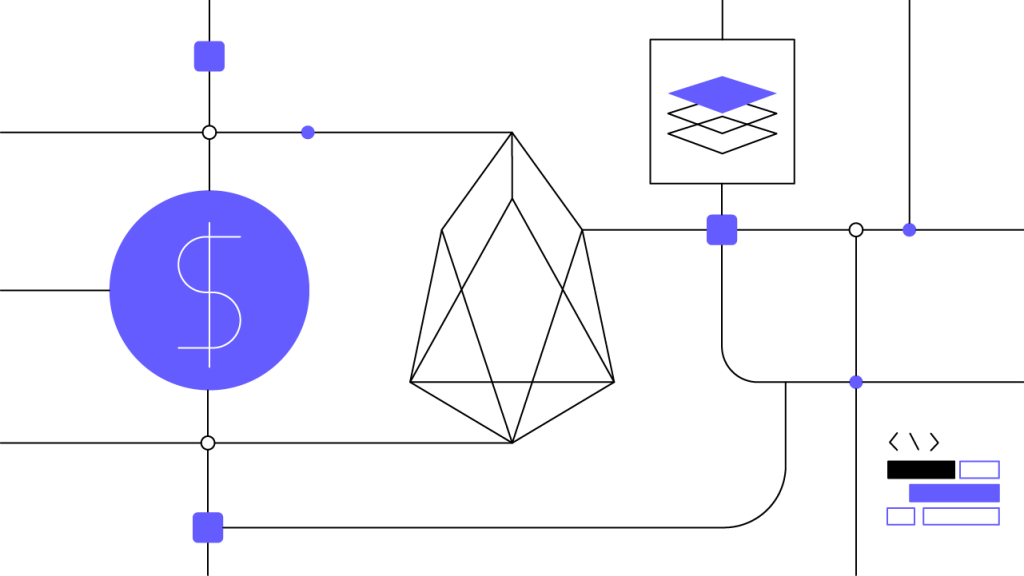Contents
EOSIO (EOS): Background, Cryptoeconomics, and Features
One of the worst things a blockchain platform can experience is a backlog, which can cause its performance to deteriorate either partially or even fully. Read how block.one’s EOSIO (EOS) can prevent backlogs from occurring.

Summary
Since starting in 2017, the EOSIO blockchain project and its public implementations, including the EOS public blockchain and its native cryptocurrency (EOS), have continued to gain momentum. Despite facing several competitors and a variety of challenges, EOSIO has firmly established itself as a leader in the blockchain space. The protocol’s cryptoeconomic and network usage models complement each other and contribute to the overall usability, scalability, and adaptability that characterize the EOSIO network.
ICO Launch and EOS Developments
The EOSIO whitepaper was originally released in 2017 and introduced what would become a visionary solution for blockchain technology. In the spring of 2018, Block.one successfully raised a record-breaking $4 billion through its (ICO). After this highly successful raise, Block.one CEO Brendan Blumer and CTO Dan Larimer continued to lead the way toward realizing the vision of the EOSIO whitepaper.
To increase the network effect of the project, a snapshot of the ERC-20 token sale was taken and open-sourced to provide a launchpad for any EOSIO-based network to use and be decentralized right upon launch. That snapshot of accounts was used by block producers to launch what we now refer to as EOS in June 2018.
Block.one is a small but significant EOS token holder, and in 2020, it established a Public Blockchain Engagement team to deepen its engagement with the EOS community and represent its interests as a token holder of EOS and other public digital assets.
Block.one began voting for block producers in 2020, and shared voting criteria for block producers to qualify for Block.one’s support.
Managing network resources is also critical to the functionality of the EOS ecosystem. Block.one has introduced a new resource allocation model that will improve efficiencies and the operations of the network by balancing demand for bandwidth with unused supply.
EOSIO Evolution
EOSIO’s initial testnet, Dawn 1.0, was launched on September 3, 2017, and the project went on to release four subsequent versions of Dawn before the official launch of EOSIO 1.0 on June 1, 2018. On January 10, 2020, the company launched EOSIO 2.0.
Main Features of the EOSIO Blockchain Ecosystem
The EOSIO blockchain platform has numerous technical characteristics that help make it extremely flexible, powerful, and easy to use:
WebAssembly-Based C++ Development
Programmable Governance and Economics
Advanced Staking Mechanism
Business Model Adaptability
Faster Confirmations, High Throughput, and Low Latency
Comprehensive Permission Schema
Full Network Upgradability
Protocol Resource-Efficiency
EOSIO is a WebAssembly (WASM) C++ development platform, which means a straightforward, yet powerful programming language is used to build smart contracts and interact with the and the EOSIO ecosystem. EOSIO and EOSIO-based blockchain platforms leverage a programmable governance and cryptoeconomic model — meaning that coin resource allocation and governance rules can be modified with minimal effort.
Users can stake EOS coins on the EOSIO platform through the Cleos Command Line Interface (CLI), using the RPC API, or via an application that accesses a platform’s CPU and NET (network bandwidth). When a user stakes through the platform’s CPU and NET, they gain rewards proportional to the number of EOS coins staked by all other users within the network.
EOSIO’s computational resource capacity is enforced by block producers, and EOSIO has structured a system where decentralized applications built on the network don’t need to force their customers to pay for the use of the blockchain network as an overall service. In other words, software engineers building on EOSIO can avoid charging for the blockchain network as a service by providing overall network services to their users for free and implementing a “sender pays” model to ensure monetization. From the viewpoint of the user, the network itself is free (only send-transactions themselves actually cost money). This creates a system that does not restrict or prevent businesses from determining the monetization strategy for their products. Applications built on EOSIO are also able to adopt a “freemium” model, meaning that application users can access basic system resources without paying, but can also pay for enhanced functionalities.
The Delegated Proof-of-Stake (DPoS) EOSIO consensus mechanism achieves extremely fast throughput. Unlike an ordinary , this system doesn’t have to wait for the network’s nodes to compete at validating new blocks in order for the system to achieve transaction finality. This means that the blockchain consistently produces faster transaction confirmations with reduced .
The EOSIO protocol employs a comprehensive permission system that enables a wide variety of use cases for the platform. For example, a developer can create a custom permission structure to safeguard a specific feature of a smart contract. The authority required to amend a smart contract can also be split across several accounts with distinct levels of authority.
Applications launched on any EOSIO-based blockchain are upgradeable. This is critical because it allows developers to make code fixes, add features, and change the application logic as long as access is given. Software developers are able to iterate on an application without potentially getting locked into specific development decisions. Conversely, it is also possible to deploy immutable smart contracts on any EOSIO-based blockchain, which can help ensure that the original design and intent of the smart contract is not tampered with.
Additionally, the DPoS consensus algorithm makes the network very efficient, allowing EOSIO to use substantially less energy than other consensus mechanisms. Energy efficiency increases of this sort are particularly important in the cryptocurrency space. For example, the demands about as much energy per year as the infrastructure of the entire Czech Republic (which supports a population of 11 million). Reducing cryptocurrency energy costs presents ethical, financial, and environmental upsides.
The diversity among EOSIO’s core features allows developers to leverage its flexibility and programmability to meet their application’s needs while reducing their environmental footprint.

Author
Is this article helpful?
